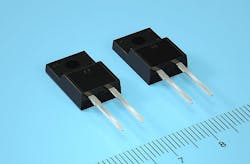Army approaches industry for new ways of packaging high-power silicon carbide (SiC) power semiconductors
Officials of the Research Triangle Park Division of the Army Contracting Command-Aberdeen Proving Ground on Wednesday issued a special notice (W911NF17S0003-SCAPOPS) for the Advanced Packaging of Power Semiconductors (APPS) II program.
This project seeks to extend the state-of-the-art in multi-die packaging of semiconductor devices for high-power applications, and demonstrate an advanced module design that provides dramatic improvements over conventional packaging methodologies.
The project is asking industry to address current limitations of conventional packaging and support the recent advancements in SiC power device technology for military and commercial applications.
The Army Contracting Command issued this special notice on behalf of the U.S. Army Research Laboratory's Sensors and Electron Devices Directorate in Research Triangle Park, N.C.
Related: Army research eyes next-generation SiC military high-voltage switching devices
Traditional power packaging approaches today are the limiting factor in realizing the performance benefits of SiC power device technology, Army researchers say. Wide-bandgap power semiconductors like as SiC have emerged that can far surpass the performance of conventional silicon (Si) power technology and make them prime candidates for next-generation high-power switching devices for military and commercial, applications.
SiC has demonstrated greater than twice the power density of Si power devices and at greater efficiency, researchers point out. Conventional power packaging has opportunities for improvement such as parasitic inductance, heat removal capability, reliability, transient thermal mitigation, planar packaging, and standard subtractive manufacturing.
Army researchers are asking industry to develop holistic multiphysics approaches to power module development that address electrical, thermal, and thermomechanical issues in SiC devices ranging from 600 volts to 3.3 kilovolts; 3.3 kilovolts to 10 kilovolts; and from 10 kilovolts to 24 kilovolts.
Thermal considerations may include heat dissipation, transient absorption, package thermal resistance, as well as internal/external thermal interfacing. The thermomechanical aspects may include compliant interface materials, coefficient of thermal expansion matching and thermal and power cycling capability.
Army researchers say they have $2.5 million set aside each for as many as four cooperative agreements over the next three years.
Companies interested should email proposals no later than 6 Oct. 2017 to the Army's Julia Wertley-Rotenberry at [email protected].
Email questions or concerns to Contracting Officer Julia Wertley-Rotenberry at [email protected], or to Kenneth Morris at [email protected].
More information is online at https://www.fbo.gov/notices/9581027299b072c439af566c71b541e7.
Learn more: search the Aerospace & Defense Buyer's Guide for companies, new products, press releases, and videos
